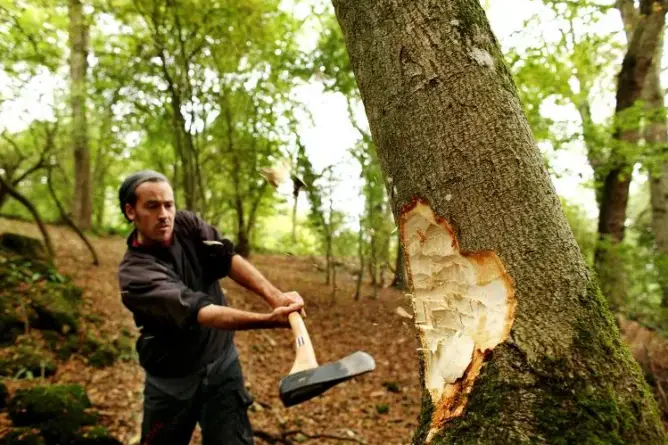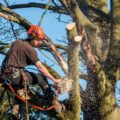Usually the question is how to cut a leaning tree in the opposite direction so that it does not cause any damage when falling. We will also tell you in which cases it is possible to do this, and when it is worth looking for other solutions.
If there are long-planted trees on your household plot, then sooner or later there will be a need to remove them. This can be dictated not only by the great age and significant size of the crown, which obscures large areas of the garden but also by the running processes of rotting, as a result of which the trunk becomes weak and the tree can collapse, damaging nearby buildings or injuring people.
Sometimes removal is resorted to in the case when the fruit tree does not yield a crop for several years. However, not everyone knows how to cut down a tall tree with a spreading top, and besides, it’s not so easy. And to do this safely, you need to have theoretical knowledge and practical experience.
Preparation for Cutting
Just knowing how to cut down a tree so that it falls in the right direction is not enough. At a minimum, for such work, you still need the necessary physical qualities for this: a high level of coordination of movements, flexibility, strength, endurance. Ideally, it is also desirable to add experience in sawing wood and cutting branches.
If all this is there, then you can start the preparatory stage-the preparation of the necessary tools and materials. You may also need additional tree service equipment.

Before cutting a leaning tree, it is necessary to prepare a properly working chainsaw with a normal chain tension, good sharpening of the links, and a serviceable lubrication system. In addition, you will need to wear comfortable shoes with a non-slip sole with a deep tread, strong work clothes, gloves, and protective glasses or a shield. Prepare a climbing safety system or a mounting belt if you plan to cut down a tree with dropping or hanging. A rope is also useful in the work: it is needed to direct the fall of the tree being cut down.
By the way! For thin trunks up to 30 cm in diameter, take a saw blade with a size of 35 cm, for 30-60-centimeter – 35-65 cm, for thicker-65 cm.
Due to the large noise pollution during the operation of a powerful chainsaw, it is recommended to insert earplugs or wear special noise-proof headphones. To protect yourself from falling branches from above, you should protect your head with a helmet.
Tools for Felling Trees
In order to bring down a tree in a certain direction, professional fellers and not only use special tools. The most common of them are felling forks, wedges, and blades. Special hydraulic or mechanical jacks can also be used.
Wedges can be made of wood directly at the place of felling or bought in specialized stores. Wedges made of polymer materials, the size of which is selected depending on the diameter of the tree being cut, are widely used.
The felling blades work on the principle of a wedge, only they have a lever, thanks to which the operator can increase the force and help the tree to fall in the right direction.
Proper Cutting of the Tree

To properly cut down a leaning tree with a chainsaw, you need to:
- choose the side in which a leaning tree will have to fall, and the height of cutting;
- cut down the branches (so that the branches do not injure the feller when the tree falls, you must first cut them down so that the trunk is bare from the height of human growth and to the ground);
- make the upper file in the trunk (made at an angle of 45° to the ground, its depth should be equal to a quarter of the diameter of the trunk, no more);
- perform the lower file (made horizontally so that its end connects with the edge of the first file, and a triangular wedge-shaped piece separates from the tree);
- make a third, felling file (made from the opposite side of the other two files, performed horizontally, parallel to the lower file, 5 cm above it);
Important! When performing the third (felling) file when fell a leaning tree, it is necessary to leave a half-saw, the value of which should be approximately 10% of the thickness of the trunk. To prevent the chainsaw from jamming when performing the most important file, you can use a wedge that was sawn off from the tree earlier.
- remove the working part of the saw from the saw and quickly move away to a safe distance from the tree being cut (the lower part of the falling trunk may jump due to inertia to a height of one to one and a half meters).
The Order of Work During the Felling of Wood
The execution of the undercuts takes place in several stages.
- The first (upper) cut is made by a quarter of the diameter of the trunk, at an angle of 45°, you need to approach the tree from the side of the fall.
- Then a cut is made from below. It is done horizontally to the level where both undercuts will connect.
- After performing two files, you should get a 45°angle cut in the trunk. Do not cut the tree completely, otherwise it will be impossible to guess in which direction its trunk will fall.
- Now a fulling cut is used. Before starting work, make sure that there are no people, pets or objects that can be damaged in the fall area. The felling cut is made from the side that is opposite to the intended direction of falling of the trunk, it should be located at a distance of five centimeters from the lower file, parallel to it. When performing a felling cut, leave a half-cut-1/10 of the total diameter of the tree trunk. This is important, as it ensures the correct trajectory of its fall.
- If you do not make this cut, or make it smaller than the specified size, the trajectory of the tree’s fall will become unpredictable.
- Sink the saw into the barrel slowly. To prevent the tire from jamming in the trunk, insert the wedge into the main cut before the tree begins to fall. The wedge must be made of plastic or wood; a metal wedge can damage the chain. The engine speed when the saw is running is maximum. While working, watch carefully where the barrel is moving. So you can take timely measures if you feel that the fall has gone in the wrong direction.
- The unfinished part of the tree is a hinge that prevents falling in an undesirable direction.
When the barrel starts to fall, quickly remove the saw from the cut, turn off the engine and leave the work area. Perform all actions quickly, delay can be dangerous.
It is more convenient to cut the tree in the direction of curvature, the greatest development of branches and branches, if the trunk is flattened – in the direction of a smaller diameter.
Roll in the Direction of Inclination

If the tree is straight and low (up to 4 meters), has a slope of at least two or three degrees, for cutting it down, you can use the technique of felling in the direction of the slope. First of all, it is necessary to decide at what height the cutting will be performed. This depends on the final purpose of the procedure:
- if the stump needs to be uprooted, the cut is made at a height of 70 cm to 1 m from ground level (the remaining part of the trunk will later serve as a lever);
- if the stump remains in the ground or it is planned to be removed with the help of chemicals, it is enough to leave 30-50 cm;
- if the stump is planned to be removed with a crusher, you need to focus on the lifting height of its cutter – you will need to leave about three-quarters of the value of this lift.
A detailed inspection of the tree will help you choose the depth of the file. A healthy plant needs a file for half of the trunk, a patient will have enough preliminary file for 20-40% of the thickness, a rotten one-about 20 %.
Let’s consider how to properly fell a leaning tree in the direction of inclination. First, you should check whether there are no obstacles in the place of the future fall of the tree (in the direction of the slope of the trunk).
After that, you need to make an inscription from the inclined side, which will become a guide. The second, deep inscription is made from the opposite side. If everything is done correctly, after these actions, the tree will begin to fall in the direction of its slope.
How to Cut Down a Leaning Tree
An important moment! If the slope of the tree does NOT exceed 5-7° from the vertical, i.e., for example, the projection of the vertex point of a 10-meter tree is at a distance of no more than one meter from the center of the future stump, then such a tree can be conditionally considered erect.
It is sawn according to the above scheme, but if the roll needs to be made in the opposite direction from the slope, two things should be taken into account:
Remember that after finishing the main cut, you will definitely have to first put the tree in the right direction, while also having to overcome the resistance of the guide chips. It is exposed, as described above, with the help of cables and other means. Also, a guide chip can help in this, if one of its edges is made wider.
The force on the ropes at some point may be too high, therefore it is necessary to use a polis past or a winch to prevent a reverse stroke.
If the slope of the tree exceeds 5-7°, it is better not to try to bring it down in a direction other than its slope, but to resort to other methods (to saw in parts or simply spend time clearing this direction, if possible).
How to Cut a Leaning Tree in the Opposite Direction
A size equal to half the diameter of the tree is required. It can be done from the slope side, or from another side from which you want to” put ” a massive tree;
Creating an incision on the opposite side with subsequent felling;
- When colliding with large trees, it is necessary to make an inclined upper cut. It is necessary to take into account the cut-off angle-60 degrees. When filing the stem part, 1\4 parts of the diameter is sufficient;
- It is necessary to make the lower cut of the file in a horizontal form. The file converges with the upper cut. Thus, we will have a side log house;
- We move on to the second horizontal file (it is higher than the previous one). The file is made strictly from the other side;
- In the 2nd file, you need to insert a wedge. As soon as the finish is completed, we take a spatula and cut down a tree.
How to Cut a Leaning Tree in the Opposite Direction If There is a House Nearby

If you are a beginner, it is not recommended to perform work on fell a leaning tree (especially large ones) near the nearest houses. There are many factors related to a specific such felling of trees.
- The slope of the stem part should not be allowed less than 45 degrees;
- The plant will have both a thin and a high trunk;
- There may be rotted areas, cracks, hollows, which can be visually noticed.
If there are a lot of houses, engineering networks, communications next to a tree, then we will have very little space for work (otherwise something can be touched). Therefore, experts in such circumstances prefer to cut down trees in parts.
That is, the element is cut down, suspended, then descends. Without special equipment and professionalism, such work should not be performed! The descent of the sawn parts of the tree occurs with the help of other trees located nearby — they are needed to bind the fragments of the tree.
Safety Precautions
To cut down a tree correctly so that it falls in the right direction means to perform a certain algorithm of actions with mandatory compliance with safety regulations. Among the rules to be followed when felling a tree, it is worth highlighting the following:
- use shoes with thick, strong, non-slip soles and special, tight clothing;
- carry out the felling only with assistants;
- check the condition of the chainsaw and its chain before felling, refuel the tool not in a closed room;
- notify the neighbors and residents of the house near which the felling is planned about the upcoming work;
- use the technique of a simple one-time cut only on small straight trees with a trunk diameter of 10-15 cm;
- start working only in a normal mental and physical condition;
- be sure to use protective glasses and a hard hat;
- hold the chainsaw with two hands when working;
- pre-think about where to go when a tree falls;
- carry out cutting work only in non-windy, non-rainy weather, in the daytime;
- fasten the safety rope when moving up the trunk in two places.
If you want to know how to cut down a tree with a chainsaw near a house read in our updated article
FAQ
How do you cut down a tree against lean?
The technology of felling large and young trees has some differences, but there are general rules that must be taken into account in the process of work:
- make an incision for half of the diameter with a chainsaw from the side of the slope or from the side into which the sawn plant should fall;
- make an incision on the opposite side and bring down the tree;
- when felling large trees, an inclined upper cut is performed at an angle of sixty degrees relative to the base of the fall side. The sawing of the stem part is performed at 20-25 % of the diameter;
- at the next stage, a horizontal lower cut of the file is made, converging with the upper cut, which will allow you to get a side frame;
- then the next horizontal file is performed above the first one and necessarily from the opposite side;
- a wedge is inserted into the second saw and after finishing the tree, the tree must be felled with a spatula.
Do you cut a tree on the opposite side you want it to fall?
The tree usually asks for the crown itself in one direction. If you need to go there, then everything is simple, cut out the wedge from the side of the fall and saw from the reverse side until it falls.
It is very easy to pull 90 degrees in any direction, for this by making a wedge saw, you start slowly sawing the side opposite to the fall, when the tree goes, you can stop the chain and wait until the remaining fibers pull the tree towards, reaching the right place, we sharply finish the remains of the trunk and it falls where it needs to. It is more difficult to bring down 180 degrees, but it is also possible.
For example, a tree is hanging to the south, and you need to bring it down to the north. We wait for the south wind, we make a drink from the north side, and then the most interesting thing. we start sawing from the south side, but only at the moment when the tree was swung by the wind to the north, and we stop when it returns.
Of course, you can make a mistake, but with a certain skill, you will finish the tree at the moment when it is tilted by a gust of wind to the north side. I had to do such things for many years, there is nothing complicated about it. In order to avoid slipping the trunk off the stump, having made a wedge cut, we saw a little higher from the reverse side, leaving a step, as it were, then the trunk will not jump to your feet when cutting through.
Should I cut down a leaning tree?
There is a risk and it is as follows:
The guide chip, which is formed at the place of the unfinished felling cut to the guide wedge, breaks before the tree has time to start its fall in the desired direction. At the same time, the tree, if it has already been placed vertically by this moment, most likely falls sideways, if it has not had time, then back, or back and to the side – in general, it is not predictable and not at all where the mountain fellers would like.
There is another realizable, but not obvious at first, scheme of emergency movement – the slip of the lump from the stump forward, with the top being held on the stretch and the trunk falling on the stump.
As you have already understood, this danger can be called as follows: “The danger of premature breaking, or the breakage of the guide chips” This danger is greatest for breeds with fragile wood, for example, all willow trees, oaks. The danger increases with poorly predictable properties of wood in the place of under-sawing, for example, for a frozen spruce, or when under-sawing falls on wood affected by rot.
The second unpleasant surprise that awaits inexperienced fellers is that the effort required to quickly put the tree into the vertical and further overturning it turns out to be unexpectedly large-many times more than expected. Therefore, with the necessary felling of inclined trees, they never operate with a drawback “manually” – only through a polis past, with a reverse stroke blocking.
What kind of slope is considered “forbidden”? – For simplicity, 10%, that is, if the removal of the vertex from the vertical is more than 10% of the height of the tree, for example, 2 meters at a tree height of 20m.
What breeds are considered “forbidden” to roll against the slope? – That’s it! Except for obviously fresh birch, and then not with frozen wood!
Read also: Cutting Tree Branches, or How Do I Cut Overhanging Limbs?





